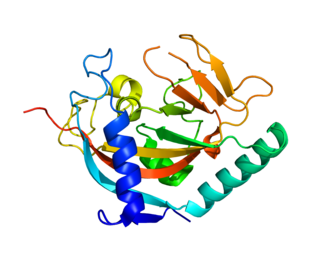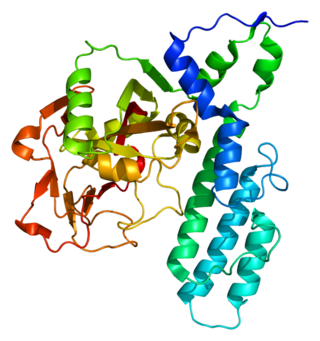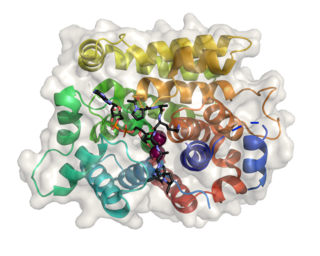Poly(ADP-ribose) polymerase family member 14 is a protein that, in humans, is encoded by the PARP14 gene. [5]
Poly(ADP-ribose) polymerase family member 14 is a protein that, in humans, is encoded by the PARP14 gene. [5]
Poly(ADP-ribosyl)ation is an immediate DNA damage-dependent post-translational modification of histones and other nuclear proteins that contributes to the survival of injured proliferating cells. PARP14 belongs to the superfamily of enzymes that perform this modification (Ame et al., 2004 [PubMed 15273990]).

Tankyrase, also known as tankyrase 1, is an enzyme that in humans is encoded by the TNKS gene. It inhibits the binding of TERF1 to telomeric DNA. Tankyrase attracts substantial interest in cancer research through its interaction with AXIN1 and AXIN2, which are negative regulators of pro-oncogenic β-catenin signaling. Importantly, activity in the β-catenin destruction complex can be increased by tankyrase inhibitors and thus such inhibitors are a potential therapeutic option to reduce the growth of β-catenin-dependent cancers.

Poly [ADP-ribose] polymerase 4 is an enzyme that in humans is encoded by the PARP4 gene.

AT-rich interactive domain-containing protein 3B is a protein that in humans is encoded by the ARID3B gene.

Poly [ADP-ribose] polymerase 3 is an enzyme that in humans is encoded by the PARP3 gene.

Ecto-ADP-ribosyltransferase 4 is an enzyme that in humans is encoded by the ART4 gene. ART4 has also been designated as CD297.

Tankyrase-2 is an enzyme that in humans is encoded by the TNKS2 gene.

182 kDa tankyrase-1-binding protein is an enzyme that in humans is encoded by the TNKS1BP1 gene.

Poly [ADP-ribose] polymerase 2 is an enzyme that in humans is encoded by the PARP2 gene. It is one of the PARP family of enzymes.

(ADP-ribosyl)hydrolase 3 (ARH3) is an enzyme that in humans is encoded by the ADPRHL2 gene (also called ADPRS). This enzyme reverses the proteins’ post-translational addition of ADP-ribose to serine residues as part of the DNA damage response The enzyme is also known to cleave poly(ADP-ribose) polymers, 1''-O-acetyl-ADP-ribose and alpha-NAD+

Poly [ADP-ribose] polymerase 8 is an enzyme that in humans is encoded by the PARP8 gene.

TCDD-inducible poly [ADP-ribose] polymerase is an enzyme that in humans is encoded by the TIPARP gene.

Poly [ADP-ribose] polymerase 12 is an enzyme that in humans is encoded by the PARP12 gene.

Poly [ADP-ribose] polymerase 10 is an enzyme that in humans is encoded by the PARP10 gene.

Poly (ADP-ribose) glycohydrolase is an enzyme that in humans is encoded by the PARG gene.

Poly (ADP-ribose) polymerase family, member 16 is a protein in humans that is encoded by the PARP16 gene.

DNA polymerase alpha subunit 2 is an enzyme that in humans is encoded by the POLA2 gene.

Deltex E3 ubiquitin ligase 3L is a protein that in humans is encoded by the DTX3L gene. It functions as an ubiquitin ligase (E3), and is over-expressed in chemotherapy-resistant lymphomas. It is a member of the DTX family of proteins. Among other roles it has a function in DNA damage repair.

HEPACAM family member 2 is a protein that in humans is encoded by the HEPACAM2 gene.

ADP-ribosyltransferase 5 is a protein that in humans is encoded by the ART5 gene.

(ADP-ribosyl)hydrolase 2 (ARH2) is a protein that in humans is encoded by the ADPRHL1 gene.
This article incorporates text from the United States National Library of Medicine, which is in the public domain.